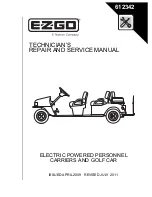
16
Battery Charger
BATTERIES
CHARGING BATTERIES
WARNING
• Be sure all wire connections at the receptacle and the fuse link are clean and tight.
• Do not rock or bend the plug. To connect the charger plug to the vehicle receptacle, grasp the plug
handle and push the plug straight into the receptacle (Figure 16-9, Page 16-21).
• Do not pull on the DC cord (Figure 16-10, Page 16-21). Do not twist, rock or bend the plug. To
disconnect the charger plug from the vehicle receptacle, grasp the plug by the handle and pull the
plug straight out of the receptacle.
• Do not connect a charger to the receptacle if the charger cord, plug, or the vehicle receptacle is
broken, damaged in any manner, or does not make a good electrical connection. Fire or personal
injury can result. Have it replaced by a qualified service person immediately.
• Failure to follow these instructions could result in damage to the charger cord, the plug, and (or)
the vehicle receptacle.
• Do not use a charger if:
– The plug is too loose or does not make a good connection.
– The plug and receptacle feel hotter than normal during charge.
– The plug pins or receptacle contacts are bent or corroded.
– The plug, receptacle, or cords are cut, worn, have any exposed wires or are damaged in any way.
• Using the charger with any of the above symptoms could result in a fire, property damage, personal
injury, or death.
NOTE:
When temperatures fall below 18.3 °C (65 °F), batteries charged in unheated areas should be placed on
charge as soon as possible after use. Batteries are warmest immediately after use, and cold batteries
require more time to fully charge.
Insert the charger DC plug into the vehicle receptacle. The charger will turn on two to ten seconds later
(Figure
16-9, Page 16-21)
.
When inserting the DC plug, align the raised guide on the plug with the guide slot in the receptacle and push
straight in slowly.
Club Car battery chargers interact with the vehicle’s onboard computer. The computer records the amount of energy
consumed during vehicle use. While the charger is plugged in, the vehicle’s control circuit is locked out, preventing
operation of the vehicle as well as the possibility of consequent damage to the charger and the vehicle.
Once the lockout is actuated, the charger turns on. The onboard computer then records the amount of energy being
returned to the batteries. When the optimum amount of energy needed to replenish the batteries is returned, the
charger will shut off. The control circuit lockout remains activated until the charger plug is disconnected from the vehicle.
Page 16-20
2009 Electric Precedent Maintenance and Service Manual





































